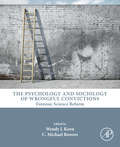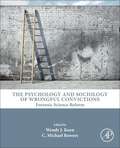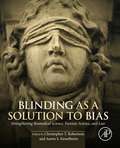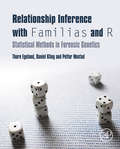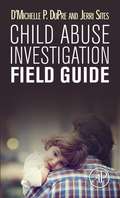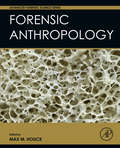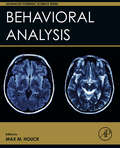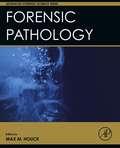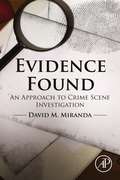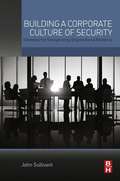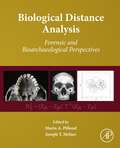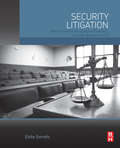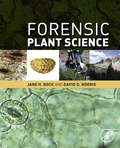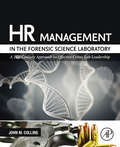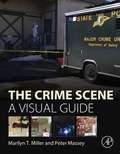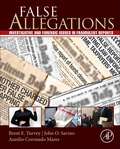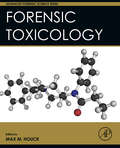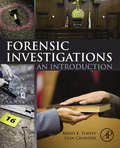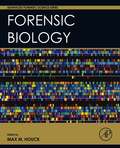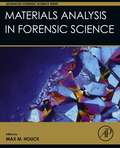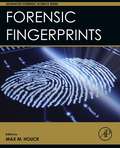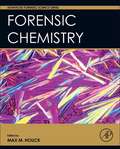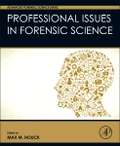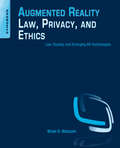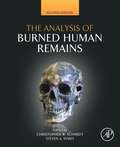- Table View
- List View
The Psychology and Sociology of Wrongful Convictions: Forensic Science Reform
by Wendy J. Koen C. Michael BowersWrongful convictions are the result of faulty or false scientific evidence in 50% of the cases. Defense counsel is often at a great disadvantage in defending against evidence based on science. Illusory Evidence: The Psychology and Sociology of Wrongful Convictions is written for the non-scientist, to make complicated scientific information clear and concise enough for attorneys and judges to master. This is obtained by providing case studies to simplify issues in forensic psychology for the legal professional.Increases the courts’ knowledge about areas of psychology that have been debunked, have advanced, or have been refined by the scientific communityCovers issues in psychological forensics, namely: Profiling, Psychological Defenses, Mitigation, Eyewitness Testimony/Identification, Child Testimony, Repressed Memories, False Confessions and Moral PanicTrains prosecuting attorneys about the present state of the forensic psychology, to avoid relying only on legal precedent and will not present flawed science to the courtProvides defense attorneys the knowledge necessary to competently defend where forensic psychology plays a part in a prosecutionArms innocence projects and appellate attorneys with the latest information to challenge convictionsUses case studies to simplify issues in forensic psychology for the legal professional
The Psychology and Sociology of Wrongful Convictions: Forensic Science Reform (PDF)
by Edited by Wendy J. Koen C. Michael BowersWrongful convictions are the result of faulty or false scientific evidence in 50% of the cases. Defense counsel is often at a great disadvantage in defending against evidence based on science. Illusory Evidence: The Psychology and Sociology of Wrongful Convictions is written for the non-scientist, to make complicated scientific information clear and concise enough for attorneys and judges to master. This is obtained by providing case studies to simplify issues in forensic psychology for the legal professional: Increases the courts’ knowledge about areas of psychology that have been debunked, have advanced, or have been refined by the scientific community; Covers issues in psychological forensics, namely: Profiling, Psychological Defenses, Mitigation, Eyewitness Testimony/Identification, Child Testimony, Repressed Memories, False Confessions and Moral Panic; Trains prosecuting attorneys about the present state of the forensic psychology, to avoid relying only on legal precedent and will not present flawed science to the court; Provides defense attorneys the knowledge necessary to competently defend where forensic psychology plays a part in a prosecution; Arms innocence projects and appellate attorneys with the latest information to challenge convictions; Uses case studies to simplify issues in forensic psychology for the legal professional.
Blinding as a Solution to Bias: Strengthening Biomedical Science, Forensic Science, and Law
by Christopher T. Robertson Aaron S. KesselheimWhat information should jurors have during court proceedings to render a just decision? Should politicians know who is donating money to their campaigns? Will scientists draw biased conclusions about drug efficacy when they know more about the patient or study population? The potential for bias in decision-making by physicians, lawyers, politicians, and scientists has been recognized for hundreds of years and drawn attention from media and scholars seeking to understand the role that conflicts of interests and other psychological processes play. However, commonly proposed solutions to biased decision-making, such as transparency (disclosing conflicts) or exclusion (avoiding conflicts) do not directly solve the underlying problem of bias and may have unintended consequences. Robertson and Kesselheim bring together a renowned group of interdisciplinary scholars to consider another way to reduce the risk of biased decision-making: blinding. What are the advantages and limitations of blinding? How can we quantify the biases in unblinded research? Can we develop new ways to blind decision-makers? What are the ethical problems with withholding information from decision-makers in the course of blinding? How can blinding be adapted to legal and scientific procedures and in institutions not previously open to this approach? Fundamentally, these sorts of questions—about who needs to know what—open new doors of inquiry for the design of scientific research studies, regulatory institutions, and courts. The volume surveys the theory, practice, and future of blinding, drawing upon leading authors with a diverse range of methodologies and areas of expertise, including forensic sciences, medicine, law, philosophy, economics, psychology, sociology, and statistics.Introduces readers to the primary policy issue this book seeks to address: biased decision-making.Provides a focus on blinding as a solution to bias, which has applicability in many domains. Traces the development of blinding as a solution to bias, and explores the different ways blinding has been employed.Includes case studies to explore particular uses of blinding for statisticians, radiologists, and fingerprint examiners, and whether the jurors and judges who rely upon them will value and understand blinding.
Relationship Inference with Familias and R: Statistical Methods in Forensic Genetics
by Thore Egeland Daniel Kling Petter MostadRelationship Inference in Familias and R discusses the use of Familias and R software to understand genetic kinship of two or more DNA samples. This software is commonly used for forensic cases to establish paternity, identify victims or analyze genetic evidence at crime scenes when kinship is involved. The book explores utilizing Familias software and R packages for difficult situations including inbred families, mutations and missing data from degraded DNA. The book additionally addresses identification following mass disasters, familial searching, non-autosomal marker analysis and relationship inference using linked markers. The second part of the book focuses on more statistical issues such as estimation and uncertainty of model parameters. Although written for use with human DNA, the principles can be applied to non-human genetics for animal pedigrees and/or analysis of plants for agriculture purposes. The book contains necessary tools to evaluate any type of forensic case where kinship is an issue.This volume focuses on the core material and omits most general background material on probability, statistics and forensic geneticsEach chapter includes exercises with available solutionsThe web page familias.name contains supporting material
Child Abuse Investigation Field Guide
by D'Michelle P. DuPre Jerri SitesChildren are suffering from a hidden epidemic of child abuse and neglect. Every year more than 3 million reports of child abuse are made in the United States involving more than 6 million children. The United States has one of the worst records among industrialized nations – losing on average between four and seven children every day to child abuse and neglect. The WHO reports that over 40 million children, below the age of 15, are subjected to child abuse each year. Domestic violence in the home increases that risk threefold. Child Abuse Investigation Field Guide is intended to be a resource for anyone working with cases involving abuse, neglect or sexual assault of children. It is designed to be a quick reference and focuses on the best practices to use during a child abuse investigation. The guide explains the Minimal Facts Interview, the Forensic Interview, and the entire process from report to court. It is understood that every state has different statutes regarding these topics; however the objectives of recognizing, reporting, and investigating cases of this nature are the same. Just as every crime scene is different, every case involving a child is different. Best practices and standard procedures exist to help ensure cases are discovered, reported and investigated properly, to ensure good documentation is obtained to achieve prosecution and conviction. This field guide will be a useful tool for law enforcement, child protective services, social service caseworkers, child advocates, and other personnel and agencies working for the welfare of children.Includes protocols and best practices for child abuse investigationsExplains the Multidisciplinary Team approach and why it is usefulDescribes the Minimal Facts Interview and the Forensic InterviewWalks the reader from the initial report, through the investigation process, to pre-trial preparation and provides tips on court testimonyPortable and affordable, the guide is tabbed for easy access of specific information while in the field and can ensure that team members are “on the same page" throughout the investigation
Forensic Anthropology (ISSN)
by Max M. HouckForensic Anthropology serves as a graduate level text for those studying and teaching forensic anthropology, as well as an excellent reference for forensic anthropologist libraries or for use in casework. Covers taphonomy, recovery and analysis, identification, statistical interpretation, and professional issues. Edited by a world-renowned leading forensic expert, the Advanced Forensic Science Series grew out of the recommendations from the 2009 NAS Report, Strengthening Forensic Science: A Path Forward, and is a long overdue solution for the forensic science community.Provides the basic principles of forensic science and an overview of forensic anthropologyContains sections on taphonomy, recovery, analysis, pathology, and identificationCovers statistical interpretation of evidence using the classical-frequentist approach and Bayesian analysis, measurement uncertainty, and standard methodsIncludes a section on professional issues, such as: from crime scene to court, expert witness testimony, and health and safetyIncorporates effective pedagogy, key terms, review questions, discussion questions, and additional reading suggestions
Behavioral Analysis (ISSN)
by Max M. HouckBehavioral Analysis, the latest release in the Advanced Forensic Science series, an ongoing reference that grew out of recommendations from the 2009 NAS Report: Strengthening Forensic Science: A Path Forward serves as a graduate level text for those studying and teaching forensic psychology, and is also an excellent reference for forensic psychologists. Coverage includes investigations, death and violence, abuse, other methods and professional issues. Edited by a world-renowned, leading forensic expert, the Advanced Forensic Science series is a long overdue solution for those in the forensic science community.Provides basic principles of forensic science and an overview of forensic behavioral analysisContains sections on investigations, abuse, death and violence Includes coverage of other methods, such as phonetics and forensic linguisticsIncludes a section on professional issues, such as crime scene to court, expert witness testimony, health and safetyIncorporates effective pedagogy, key terms, review questions, discussion questions and additional reading suggestions
Forensic Pathology (ISSN)
by Max M. HouckForensic Pathology, the latest volume in the Advanced Forensic Science series that grew out of the recommendations from the 2009 NAS Report serves as a graduate level text for those studying and teaching forensic pathology, and is an excellent reference for forensic pathologists’ libraries or for use in their casework. Coverage includes postmortem interval, autopsy, trauma, causes of death, identification, and professional issues. Edited by a world-renowned leading forensic expert, this series provides a long overdue solution for the forensic science community. Provides basic principles of forensic science and an overview of forensic pathologyContains sections on postmortem interval, autopsy, trauma, causes of death, and identificationIncludes a section on professional issues, such as crime scene to court, expert witness testimony, health and safety, deaths in custody, and suicideIncorporates effective pedagogy, key terms, review questions, discussion questions, and additional reading suggestions
Evidence Found: An Approach to Crime Scene Investigation
by David MirandaEvidence Found: An Approach to Crime Scene Investigation is not another analysis of forensic errors using an "After the Fact" or "Lessons Learned" approach but a "Before the Fact" guide that examines the thought processes that can lead to those mistakes. Plus a few extras tips and tricks from the author’s experience of over 25 years. Many high-profile crime scene investigations (and routine ones, for that matter) have suffered errors that have had negative impact on the investigation result and in the courtroom. Typically, we examine what happened and develop a useful list of what to do and what not to do, fixing the symptoms but potentially leaving ourselves open to the same error type on the next scene. The reason? Many crime scene mistakes are the result of systemic issues that are repeated due to a failure to include an evaluation of the decision-making process, including our own foundations of knowledge. Through case study and logical argument, this book attempts to provide a framework to recognize, evaluate, and alter negative decision-making patterns, including evaluating our own experience, before they negatively impact an investigation or the overall operation of a forensic unit. Enhances the base concepts of evidence search and sequential processing for error avoidanceExamines the systemic areas/practices of a crime scene investigation where errors can occurIncludes a Evidence Matrix - a crime scene evaluation tool that aids in sequential processing decisionsContains tips on overcoming common crime scene issues, inlcuding night time searchesProvides courtroom Testimony - communicating comparison findings to a jury
Building a Corporate Culture of Security: Strategies for Strengthening Organizational Resiliency
by John SullivantBuilding a Corporate Culture of Security: Strategies for Strengthening Organizational Resiliency provides readers with the proven strategies, methods, and techniques they need to present ideas and a sound business case for improving or enhancing security resilience to senior management. Presented from the viewpoint of a leading expert in the field, the book offers proven and integrated strategies that convert threats, hazards, risks, and vulnerabilities into actionable security solutions, thus enhancing organizational resiliency in ways that executive management will accept. The book delivers a much-needed look into why some corporate security practices programs work and others don’t. Offering the tools necessary for anyone in the organization charged with security operations, Building a Corporate Culture of Security provides practical and useful guidance on handling security issues corporate executives hesitate to address until it’s too late.Provides a comprehensive understanding of the root causes of the most common security vulnerabilities that impact organizations and strategies for their early detection and preventionOffers techniques for security managers on how to establish and maintain effective communications with executives, especially when bringing security weakness--and solutions--to themOutlines a strategy for determining the value and contribution of protocols to the organization, how to detect gaps, duplications and omissions from those protocols, and how to improve their purpose and usefulnessExplores strategies for building professional competencies; managing security operations, and assessing risks, threats, vulnerabilities, and consequencesShows how to establish a solid foundation for the layering of security and building a resilient protection-in-depth capability that benefits the entire organizationOffers appendices with proven risk management and risk-based metric frameworks and architecture platforms
Biological Distance Analysis: Forensic and Bioarchaeological Perspectives
by Marin A. Pilloud Joseph T. HefnerBiological Distance Analysis: Forensic and Bioarchaeological Perspectives synthesizes research within the realm of biological distance analysis, highlighting current work within the field and discussing future directions. The book is divided into three main sections. The first section clearly outlines datasets and methods within biological distance analysis, beginning with a brief history of the field and how it has progressed to its current state. The second section focuses on approaches using the individual within a forensic context, including ancestry estimation and case studies. The final section concentrates on population-based bioarchaeological approaches, providing key techniques and examples from archaeological samples. The volume also includes an appendix with additional resources available to those interested in biological distance analyses.Defines datasets and how they are used within biodistance analysisApplies methodology to individual and population studiesBridges the sub-fields of forensic anthropology and bioarchaeologyHighlights current research and future directions of biological distance analysisIdentifies statistical programs and datasets for use in biodistance analysisContains cases studies and thorough index for those interested in biological distance analyses
Security Litigation: Best Practices for Managing and Preventing Security-Related Lawsuits
by Eddie SorrellsSecurity Litigation: Best Practices for Managing and Preventing Security-Related Lawsuits provides practical guidance and examples on how to deal with the most difficult legal issues that security executives face every day, also exploring the key issues that occur before, during, and after a lawsuit. The book demonstrates scenarios that have actually played out in courtrooms, depositions, and contractual negotiations, and provides answers to challenging security litigation questions such as, What does this contractual provision mean if we get sued? Am I in legal trouble if I assign unarmed vs. armed officers and a crime occurs? How do I defend my company without blaming my customer? Increasingly, issues such as security surveys, contractual indemnification, and even marketing language are at the center of lawsuits concerning security practices. Many organizations face security-related lawsuits on an increasing basis, and this book provides a much needed resource to help security professionals successfully navigate the unique nature of security-related lawsuits. Accessibly written for those without a law background, the book assists readers through education, awareness, sample contract language, and assessment templates, offering meaningful recommendations and solutions.Presents practical guidelines for security professionals involved in the prevention of security-related lawsuitsDemonstrates how to address real world problems not always found in case law or rules of evidenceProvides a much needed resource to help security professionals successfully navigate the unique nature of security-related lawsuits Offers learning aids such as sample documents and graphs that illustarte common liability issues, along with documents from actual cases
Forensic Plant Science
by Jane H Bock David O. NorrisForensic botany is the application of plant science to the resolution of legal questions. A plant’s anatomy and its ecological requirements are in some cases species specific and require taxonomic verification; correct interpretation of botanical evidence can give vital information about a crime scene or a suspect or victim. The use of botanical evidence in legal investigations in North America is relatively recent. The first botanical testimony to be heard in a North American court concerned the kidnapping and murder of Charles Lindbergh’s baby boy and the conviction of Bruno Hauptmann in 1935. Today, forensic botany encompasses numerous subdisciplines of plant science, such as plant anatomy, taxonomy, ecology, palynology, and diatomology, and interfaces with other disciplines, e.g., molecular biology, limnology and oceanography. Forensic Plant Science presents chapters on plant science evidence, plant anatomy, plant taxonomic evidence, plant ecology, case studies for all of the above, as well as the educational pathways for the future of forensic plant science. Provides techniques, collection methods, and analysis of digested plant materials Shows how to identify plants of use for crime scene and associated evidence in criminal cases The book’s companion website: http://booksite.elsevier.com/9780128014752, will host a microscopic atlas of common food plants.
HR Management in the Forensic Science Laboratory: A 21st Century Approach to Effective Crime Lab Leadership
by John M. CollinsHR Management in the Forensic Science Laboratory: A 21st Century Approach to Effective Crime Lab Leadership introduces the profession of forensic science to human resource management, and vice versa. The book includes principles of HR management that apply most readily, and most critically, to the practice of forensic science, such as laboratory operations, staffing and assignments, laboratory relations and high impact leadership. A companion website hosts workshop PowerPoint slides, a forensic HR newsletter and other important HR strategies to assist the reader.Provides principles of HR management that readily apply to the practice of forensic scienceCovers and emphasizes the knowledge necessary to make HR management in the forensic science laboratory effective, such as technical standards and practices, laboratory structures and work units, and quality system management Includes an online website that hosts workshop PowerPoint slides, a forensic HR newsletter and other important HR strategies
The Crime Scene: A Visual Guide
by Marilyn T. Miller Peter MasseyThe Crime Scene: A Visual Guide provides visual instruction on the correct way to process a crime scene. While the primary crime scene comprises the area from which most of the physical evidence is retrieved by crime scene investigators (CSIs), forensic scientists, or law enforcement personnel, this book also covers secondary and often tertiary crime scenes, all locations where there is the potential for the recovery of evidence. By using photographs and other diagrams to show proper and improper procedures, the reader will learn how to identify the correct principles required to process a scene. The book presents chapters on the investigation, the varying types of documentation, and the tactics used to connect events through crime scene reconstruction using evidence The book's authors have a combined experience of over 70 years in crime scene investigation as primary responders and consultants giving testimony in all levels of the U.S. court system. In addition, both teach forensic science and crime scene investigation at the university level.Coverage of techniques, documentation and reconstruction at a crime scene Shows side-by-side comparison of the correct process versus the incorrect processOnline website will host: videos and additional instructional material
False Allegations: Investigative And Forensic Issues In Fraudulent Reports Of Crime (PDF)
by Brent E. Turvey John O. Savino Aurelio Coronado MaresFalse Allegations: Investigative and Forensic Issues in Fraudulent Reports of Crime provides investigators and forensic examiners with a reference manual comprised of objective protocols for managing cases. It helps them understand the nature and extent of false allegations to more accurately identify false allegations should they present in casework. It also prepares users on how to confront and explain false allegations, including instances where colleagues and supervisors may be steeped in bias, denial or self-interest. Responding law enforcement agencies have a duty of care to investigate all reported crime, to recognize and uncover false allegations, and prevent them from causing harm to the innocent. Failure to do so can result in miscarriages of justice. When law enforcement fails in their duty of care, they are also exposed to civil liability from those that have been falsely accused.
Forensic Toxicology (ISSN)
by Max M. HouckForensic Toxicology, the latest release in the Advanced Forensic Science Series that grew out of recommendations from the 2009 NAS Report, Strengthening Forensic Science: A Path Forward will serve as a graduate level text for those studying and teaching forensic toxicology. It is also an excellent reference for the forensic practitioner’s library or for use in their casework. Coverage includes a wide variety of methods used, along with pharmacology and drugs and professional issues they may encounter. Edited by a world-renowned, leading forensic expert, this updated edition is a long overdue solution for the forensic science community.Provides basic principles of forensic science and an overview of forensic toxicologyContains information on a wide variety of methodsCovers pharmacology and drugs, matrices and interpretationIncludes a section on professional issues, such as crime scene to court, lab reports, health and safety, post-mortem and drug facilitated crimesIncorporates effective pedagogy, key terms, review questions, discussion questions and additional reading suggestions
Forensic Investigations: An Introduction
by Brent E. Turvey Stan CrowderThe terms forensic investigator and forensic investigation are part of our cultural identity. They can be found in the news, on television, and in film. They are invoked, generally, to imply that highly trained personnel will be collecting some form of physical evidence with eventual scientific results that cannot be questioned or bargained with. In other words, they are invoked to imply the reliability, certainty, and authority of a scientific inquiry. Using cases from the authors’ extensive files, Forensic Investigations: An Introduction provides an overview of major subjects related to forensic inquiry and evidence examination. It will prepare Criminal Justice and Criminology students in forensic programs for more specialized courses and provide a valuable resource to newly employed forensic practitioners. Written by practicing and testifying forensic professionals from law enforcement, academia, mental health and the forensic sciences, this work offers a balanced scientific approach, based on the established literature, for broad appeal. The purpose of this book is to help students and professionals rid themselves of the myths and misconceptions they have accumulated regarding forensic investigators and the subsequent forensic investigations they help to conduct. It will help the reader understand the role of the forensic investigator; the nature and variety of forensic investigations that take place in the justice system; and the mechanisms by which such investigations become worthy as evidence in court. Its goals are no loftier than that. However, they could not be more necessary to our understanding of what justice is, how it is most reliably achieved, and how it can be corrupted by those who are burdened with apathy and alternative motives.A primary text for instructors teaching forensic courses related to criminal and forensic investigationWritten by forensic professionals, currently in practice and testifying in courtOffers applied protocols for a broad range of forensic investigationsAugments theoretical constructs with recent, and relevant case studies and forensic reportsBased on the most recent scientific research, practice, and protocols related to forensic inquiry
Forensic Biology (Advanced Forensic Science Ser.)
by Max M. HouckForensic Biology provides coordinated expert content from world-renowned leading authorities in forensic biology. Covering the range of forensic biology, this volume in the Advanced Forensic Science Series provides up-to-date scientific learning on DNA analysis. Technical information, written with the degreed professional in mind, brings established methods together with newer approaches to build a comprehensive knowledge base for the student and practitioner alike. LIke each volume in the Advanced Forensic Science Series, review and discussion questions allow the text to be used in classrooms, training programs, and numerous other applications. Sections on fundamentals of forensic science, history, safety, and professional issues provide context and consistency in support of the forensic enterprise. Forensic Biology sets a new standard for reference and learning texts in mondern forensic science.
Materials Analysis in Forensic Science (Advanced Forensic Science Ser.)
by Max M. HouckMaterials Analysis in Forensic Science will serve as a graduate level text for those studying and teaching materials analysis in forensic science. In addition, it will prove an excellent library reference for forensic practitioners to use in their casework. Coverage includes methods, textiles, explosives, glass, coatings, geo-and bio-materials, and marks and impressions, as well as information on various other materials and professional issues the reader may encounter. Edited by a world-renowned leading forensic expert, the book is a long overdue solution for the forensic science community.
Forensic Fingerprints (Advanced Forensic Science Ser.)
by Max M. HouckForensic Fingerprints, the latest in the Advanced Forensic Science Series which grew out of the recommendations from the 2009 NAS Report: Strengthening Forensic Science: A Path Forward, serves as a graduate level text for those studying and teaching fingerprint detection and analysis, and will also prove to be an excellent reference for forensic practitioner libraries and for use in casework. Coverage includes fingerprint science, friction ridge print examination, AFIS, foot and palm prints, and the professional issues practitioners may encounter. Edited by a world-renowned leading forensic expert, this book is a long overdue solution for the forensic science community.
Forensic Chemistry (Advanced Forensic Science Ser.)
by Max M. HouckForensic Chemistry is the first publication to provide coordinated expert content from world-renowned leading authorities in forensic chemistry. Covering the range of forensic chemistry, this volume in the Advanced Forensic Science Series provides up-to-date scientific learning on drugs, fire debris, explosives, instrumental methods, interpretation, and more. Technical information, written with the degreed professional in mind, brings established methods together with newer approaches to build a comprehensive knowledge base for the student and practitioner alike. Like each volume in the Advanced Forensic Science Series, review and discussion questions allow the text to be used in classrooms, training programs, and numerous other applications. Sections on fundamentals of forensic science, history, safety, and professional issues provide context and consistency in support of the forensic enterprise. Forensic Chemistry sets a new standard for reference and learning texts in modern forensic science.
Professional Issues in Forensic Science (Advanced Forensic Science Ser.)
by Max M. HouckProfessional Issues in Forensic Science will introduce students to various topics they will encounter within the field of Forensic Science. Legal implications within the field will focus on expert witness testimony and procedural rules defined by both legislative statute and court decisions. These decisions affect the collection, analysis, and court admissibility of scientific evidence, such as the Frye and Daubert standards and the Federal Rules of Evidence. Existing and pending Forensic Science legislation will be covered, including laws governing state and national DNA databases. Ethical concerns stemming from the day-to-day balancing of competing priorities encountered by the forensic student will be discussed. Such competing priorities may cause conflicts between good scientific practice and the need to expedite work, meet legal requirements, and satisfy client's wishes. The role of individual morality in Forensic Science and competing ethical standards between state and defense experts will be addressed. Examinations of ethical guidelines issued by various professional forensic organizations will be conducted. Students will be presented with examples of ethical dilemmas for comment and resolution. The management of crime laboratories will provide discussion on quality assurance/quality control practices and the standards required by the accreditation of laboratories and those proposed by Scientific Working Groups in Forensic Science. The national Academy of Sciences report on Strengthening Forensic Science will be examined to determine the impact of the field. Professional Issues in Forensic Science is a core topic taught in forensic science programs. This volume will be an essential advanced text for academics and an excellent reference for the newly practicing forensic scientist. It will also fit strategically and cluster well with our other forensic science titles addressing professional issues.
Augmented Reality Law, Privacy, and Ethics: Law, Society, and Emerging AR Technologies
by Brian WassomAugmented Reality (AR) is the blending of digital information in a real-world environment. A common example can be seen during any televised football game, in which information about the game is digitally overlaid on the field as the players move and position themselves. Another application is Google Glass, which enables users to see AR graphics and information about their location and surroundings on the lenses of their "digital eyewear", changing in real-time as they move about. Augmented Reality Law, Privacy, and Ethics is the first book to examine the social, legal, and ethical issues surrounding AR technology. Digital eyewear products have very recently thrust this rapidly-expanding field into the mainstream, but the technology is so much more than those devices. Industry analysts have dubbed AR the "eighth mass medium" of communications. Science fiction movies have shown us the promise of this technology for decades, and now our capabilities are finally catching up to that vision. Augmented Reality will influence society as fundamentally as the Internet itself has done, and such a powerful medium cannot help but radically affect the laws and norms that govern society. No author is as uniquely qualified to provide a big-picture forecast and guidebook for these developments as Brian Wassom. A practicing attorney, he has been writing on AR law since 2007 and has established himself as the world's foremost thought leader on the intersection of law, ethics, privacy, and AR. Augmented Reality professionals around the world follow his Augmented Legality® blog. This book collects and expands upon the best ideas expressed in that blog, and sets them in the context of a big-picture forecast of how AR is shaping all aspects of society.Augmented reality thought-leader Brian Wassom provides you with insight into how AR is changing our world socially, ethically, and legally.Includes current examples, case studies, and legal cases from the frontiers of AR technology.Learn how AR is changing our world in the areas of civil rights, privacy, litigation, courtroom procedure, addition, pornography, criminal activity, patent, copyright, and free speech.An invaluable reference guide to the impacts of this cutting-edge technology for anyone who is developing apps for it, using it, or affected by it in daily life.
The Analysis of Burned Human Remains
by Steven A. Symes Christopher W. SchmidtThe Analysis of Burned Human Remains, Second Edition, provides a primary source for osteologists and the medical/legal community for the understanding of burned bone remains in forensic or archaeological contexts. It describes in detail the changes in human bone and soft tissues as a body burns at both the chemical and gross levels and provides an overview of the current procedures in burned bone study. Case studies in forensic and archaeological settings aid those interested in the analysis of burned human bodies, from death scene investigators to biological anthropologists.A timely state-of-the-art analyses of burned bone studies for bioarchaeologists and forensic anthropologistsCovers the diagnostic patterning of color changes, the positioning of the body, and presence (or absence of soft tissues during the burning eventChapters on bones and teeth give step-by-step recommendations for hot to study and recognize burned hard tissuesNew chapters include improved analyses of thermally induced impacts on bone microstructure, development, and appearance; they also cover sites from a greater geographic range adding Alaska, Italy, Jordan, Mexico, and Southeast Asia
